Research on the Influence of Geotextile and Elastic Cushion on the Static Performance of Ballastless Track on Long-Span Cable-Stayed Bridges
Abstract
:1. Introduction
2. Engineering Background
3. Finite Element Modeling
3.1. Model of Cable-Stayed Bridge-Ballastless Track
3.2. Material Parameters
3.3. Simulation of Geotextile and Elastic Cushion
3.4. Model Verification
4. Influence of Geotextile and Elastic Cushion on Seamless Line on the Bridge
4.1. Vertical Load
4.2. Braking Load
4.3. Temperature Load
4.4. Strength Calculation of Seamless Tracks
4.4.1. Thermal Stress in Rails
4.4.2. Dynamic Bending Stress of Rails
4.4.3. Rail Braking Stress
4.4.4. Additional Stress in Rails
5. Influence of Geotextile and Elastic Cushion on Deformation of Track Structure on the Bridge
5.1. Vertical Load
5.2. Brake Load
5.3. Temperature Load
6. Influence of Geotextile and Elastic Cushion on Track Seam Separation
6.1. Vertical Load
6.2. Brake Load
6.3. Temperature Load
7. Conclusions
- (1)
- Under different load types, the geotextile and elastic cushion laid on the ballastless track on the long-span cable-stayed bridge have little influence on the longitudinal mechanical characteristics of the seamless line. Deformation in the track is within allowable limits; it can be considered a priority to use geotextiles when laying ballastless tracks.
- (2)
- When an elastic layer is laid, the total stress of the seamless track rail is 281.4 MPa. When geotextile is laid, the total stress of the seamless track rail is 281.3 MPa. The material used for laying has a minimal impact on the strength calculation of the rail, and it is within the safety range.
- (3)
- Under different load types, when the geotextile is laid on the ballastless track on the long-span cable-stayed bridge, the longitudinal stress of the track structure does not exceed the allowable strength of concrete. Under vertical load, braking load, and temperature load, laying elastic cushion, the stress peak value of the plate can be reduced by 0.13 MPa, 0.025 MPa, and 0.06 MPa, respectively.
- (4)
- The elastic cushion laid on the ballastless track of the long-span cable-stayed bridge can reduce the seam height of the track slab and the base plate near the cable tower or restrain the generation of seam under vertical load; under the braking load and temperature load, laying elastic cushion or geotextile has no obvious effect on inhibiting the separation of track structure, but the separation height is less than 0.4 mm.
- (5)
- Compared with laying geotextile, laying elastic cushion on a ballastless track on a long-span cable-stayed bridge has advantages in statics; when the geotextile is laid on the ballastless track on the bridge, although some indexes are greater than the elastic cushion, they do not exceed the standard, which indicates that it is feasible to lay the geotextile on the ballastless track on the long-span cable-stayed bridge. To reduce engineering costs or the complexity of future maintenance, geotextile isolation layers can be considered.
- (6)
- This paper only analyzes the difference between geotextile and elastic cushions from the perspective of statics. In the future, it will be necessary to analyze the difference between geotextile and elastic cushions from the perspective of dynamics and give a more comprehensive analysis compared with other codes of practice like AASHTO and conclusion, which is also the next work goal and direction. Areas such as how to replace the elastic cushion after it is damaged and the law of force change are also good directions of study.
Author Contributions
Funding
Institutional Review Board Statement
Informed Consent Statement
Data Availability Statement
Conflicts of Interest
References
- Chen, L.; Zhou, Y. Development and Practice of High-speed Railway Bridge Technology in China. High Speed Railw. Technol. 2020, 11, 27–32. [Google Scholar]
- Li, D.; Wen, W.; Yan, A.; Wang, B.; Zhang, Z. Engineering Practice of Laying Ballastless Track on Long Span Cable-stayed Bridge. J. Railw. Eng. Soc. 2020, 37, 78–82. [Google Scholar]
- Zuo, J. Applicability Research on the Low-pylon Cable-stayed Bridge to Ballastless Track in Shangqiu-Hefei-Hangzhou Railway. J. Railw. Eng. Soc. 2018, 35, 36–40. [Google Scholar]
- Yang, H.; Li, H.; Yan, Z.; Jiao, Y.; Jian, F.; Li, J.; Yang, X. Design and Research on High-Speed Railway Long-span Mixed Beam Cable-Stayed Bridge with Ballastless Track. J. Railw. Stand. Des. 2021, 65, 83–88. [Google Scholar]
- Sheng, X.; Zheng, W.; Zhu, Z.; Yan, A.; Qin, Y. Ganjiang Bridge: A high-speed railway long-span cable-stayed bridge laying ballastless tracks. Struct. Eng. Int. 2019, 31, 40–44. [Google Scholar] [CrossRef]
- Zhu, Z.; Yan, M.; Li, X.; Sheng, X.; Gao, Y.; Yu, Z. Deformation Adaptability of Long-Span Cable-Stayed Bridge and Ballastless Track Structure. Chin. Railw. Sci. 2019, 40, 16–24. [Google Scholar]
- Han, Z.; Zhu, S.; Zhai, W.; Zhu, B. Static and dynamic effects of train-track-bridge system subject to environment-induced deformation of long-span railway bridge. Proc. Inst. Mech. Eng. Part F J. Rail Rapid Transit 2023, 237, 93–103. [Google Scholar] [CrossRef]
- Sheng, X.; Zheng, W.; Wu, J.; Zhang, H. Influence of local deformation mode of cable-stayed bridge on unballasted tracks: Experimental research. Adv. Civ. Eng. 2020, 6, 2316524. [Google Scholar] [CrossRef]
- Zheng, W.; Sheng, X.; Zhu, Z.; He, H. Experimental study on deformation characteristics of ballastless tracks under downward bending deformation of long-span cable-stayed bridge. Eng. Struct. 2020, 210, 110363. [Google Scholar] [CrossRef]
- Zheng, W.; Sheng, X.; Zhu, Z.; Shi, T. Effect of reverse bending deformation of large-span cable-stayed bridge on ballastless tracks’ behaviors. Struct. Eng. Mech. 2021, 80, 169–179. [Google Scholar]
- Sheng, X.; Zheng, W.; Zhu, Z. Mechanical behaviors and fatigue performances of ballastless tracks laid on long-span cable-stayed bridges with different arrangements. Sensors 2019, 19, 4195. [Google Scholar] [CrossRef] [PubMed]
- Qin, S.; Han, S.; Li, S. In-situ testing and finite element model updating of a long-span cable-stayed bridge with ballastless track. Structures 2022, 45, 1412–1423. [Google Scholar] [CrossRef]
- Wang, S.; Luo, J.; Zhu, S.; Han, Z.; Zhao, G. Random dynamic analysis on a high-speed train moving over a long-span cable-stayed bridge. Int. J. Rail Transp. 2022, 10, 331–351. [Google Scholar] [CrossRef]
- Li, D. Feasibility Study and Design Optimization of Ballastless Track for 450 m Main Span Cable-stayed Bridge of High-Speed Railways. J. Railw. Stand. Des. 2023, 67, 24–29. [Google Scholar]
- Xie, H.; Kou, S.; Xu, L.; Huang, J.; Liu, F. Mechanical Characteristics of Ballastless Track System on Long-span Cable-stayed Bridge. J. Railw. Eng. 2022, 62, 1–8. [Google Scholar]
- Qing, Y. Research on Adaptability of Ballastless Track of High-speed Railway with Long-span Stayed-cable Bridge. High Speed Railw. Technol. 2020, 11, 22–27. [Google Scholar]
- Sheng, X.; Zheng, W.; Zhu, Z.; Qin, Y.; Guo, J. Full-scale fatigue test of unit-plate ballastless track laid on long-span cable-stayed bridge. Constr. Build. Mater. 2020, 247, 118601. [Google Scholar] [CrossRef]
- Cai, X.; Liu, W.; Xie, K.; Zhu, W. Layout Optimization of Rail Expansion Joint on Long-Span Cable-Stayed Bridge for High-Speed Railway. Adv. Civ. Eng. 2020, 5, 8855140. [Google Scholar] [CrossRef]
- Zhao, G.; Cai, X.; Liu, W.; Wang, T.; Wang, T. Mechanical Properties and Structural Optimization of Continuous Welded Rail on Super-Long-Span Suspension Bridges for High-Speed Railway. Appl. Sci. 2021, 12, 305. [Google Scholar] [CrossRef]
- Yan, B.; Kuang, W.; Gan, R.; Xie, H.; Huang, J. Track–Bridge Interaction of CWR on Chinese Large-Span Bridge of High-Speed Railway. Appl. Sci. 2022, 12, 9100. [Google Scholar] [CrossRef]
- Gou, H.; Zhao, T.; Qin, S.; Zheng, X.; Pipinato, A.; Bao, Y. In-situ testing and model updating of a long-span cable-stayed railway bridge with hybrid girders subjected to a running train. Eng. Struct. 2022, 253, 113823. [Google Scholar] [CrossRef]
- Wang, F.; Dai, G.; Liu, Y.; Ge, H.; Rao, H. Investigation of the Temperature Actions of Bridge Cables Based on Long-Term Measurement and the Gradient Boosted Regression Trees Method. Sensors 2023, 23, 5675. [Google Scholar] [CrossRef] [PubMed]
- Li, Y. Study on Variation Rules of Longitudinal Force of Continuous Welded Rails on Long-span Cable-stayed Bridge. J. Railw. Eng. Soc. 2012, 29, 42–46. [Google Scholar]
- Fan, Y.; Zhao, H.; Li, A.; Fang, Z. Experimental–Numerical Analysis on the Cable Vibration Behavior of a Long-Span Rail-Cum-Road Cable-Stayed Bridge under the Action of High-Speed Trains. Appl. Sci. 2023, 13, 11082. [Google Scholar]
- Ren, J.; Tian, G.; Feng, X.; Yan, Y. Influence of Rubber Pad Ageing on Dynamic Characteristics of CRTS I Slab Ballastless Track Structure. J. Railw. Eng. 2017, 517, 106–110. [Google Scholar]
- Liu, W.; Wang, J.; Du, X.; Zhao, Y.; Wang, M.; Liu, H.; Zhao, L. Technical Requirements of EPDM Isolation Layer Used in CRTS III-type Slab Ballastless Track. China Railw. 2018, 671, 64–70. [Google Scholar]
- TB10095-2020; Code for Design on Railway Cable-stayed Bridge. Chinese Standard GB/T: Beijing, China, 2020.
- TB10015-2012; Code for Design of Railway Continuous Welded Rail. Chinese Standard GB/T: Beijing, China, 2012.

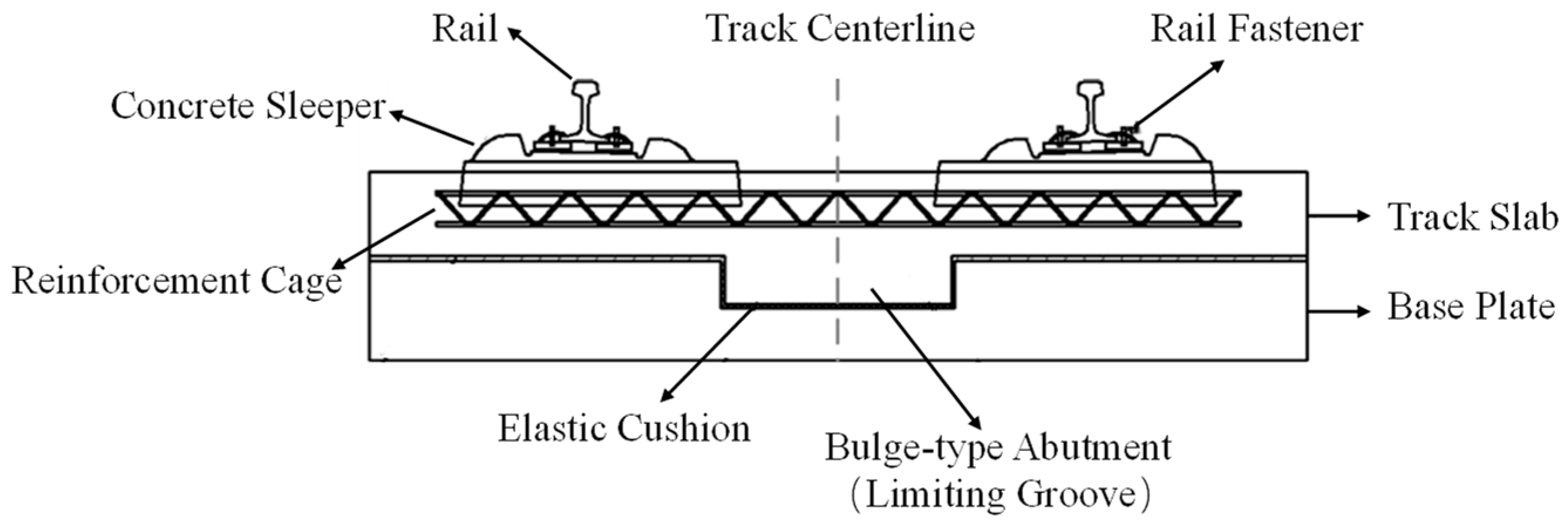


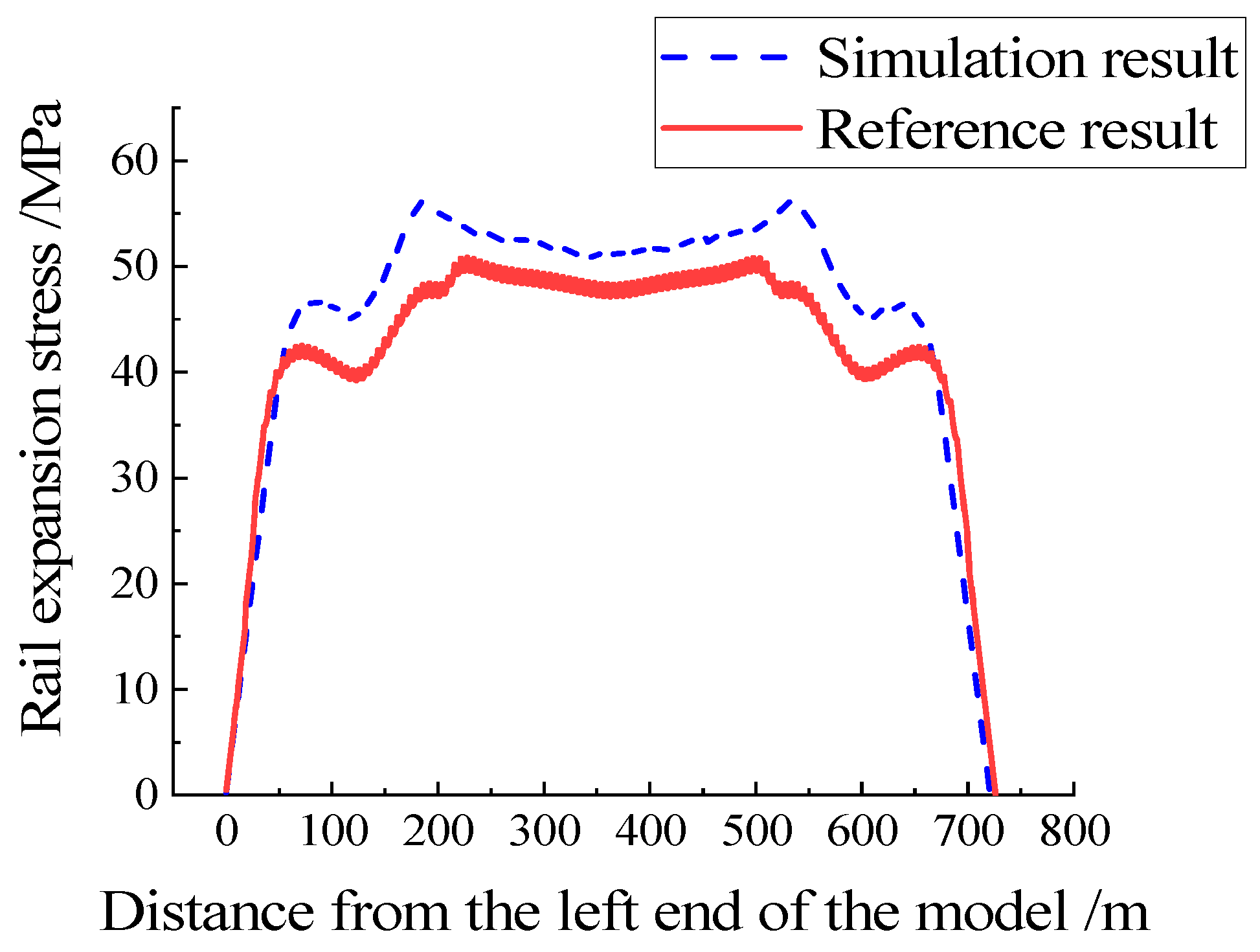
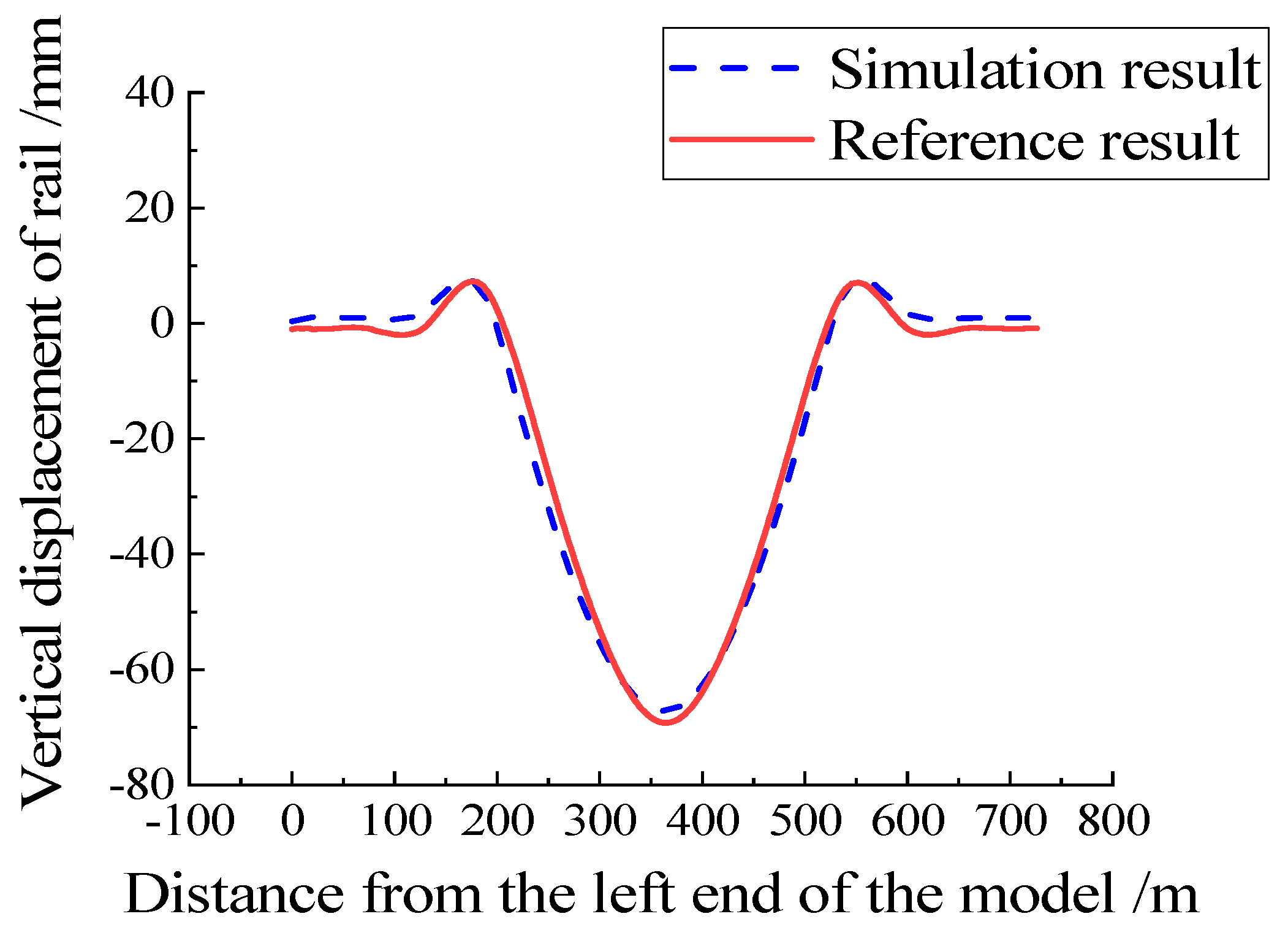


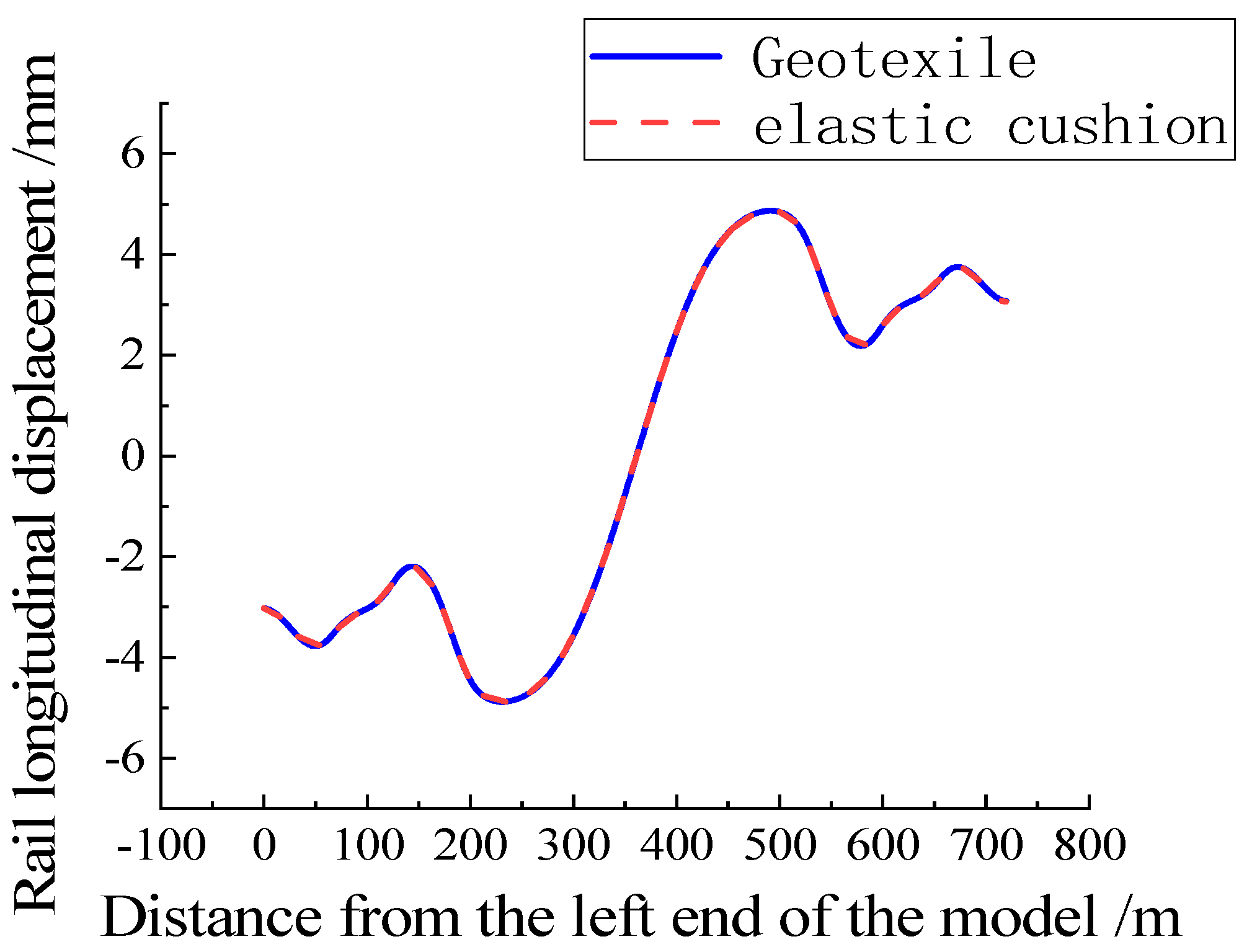


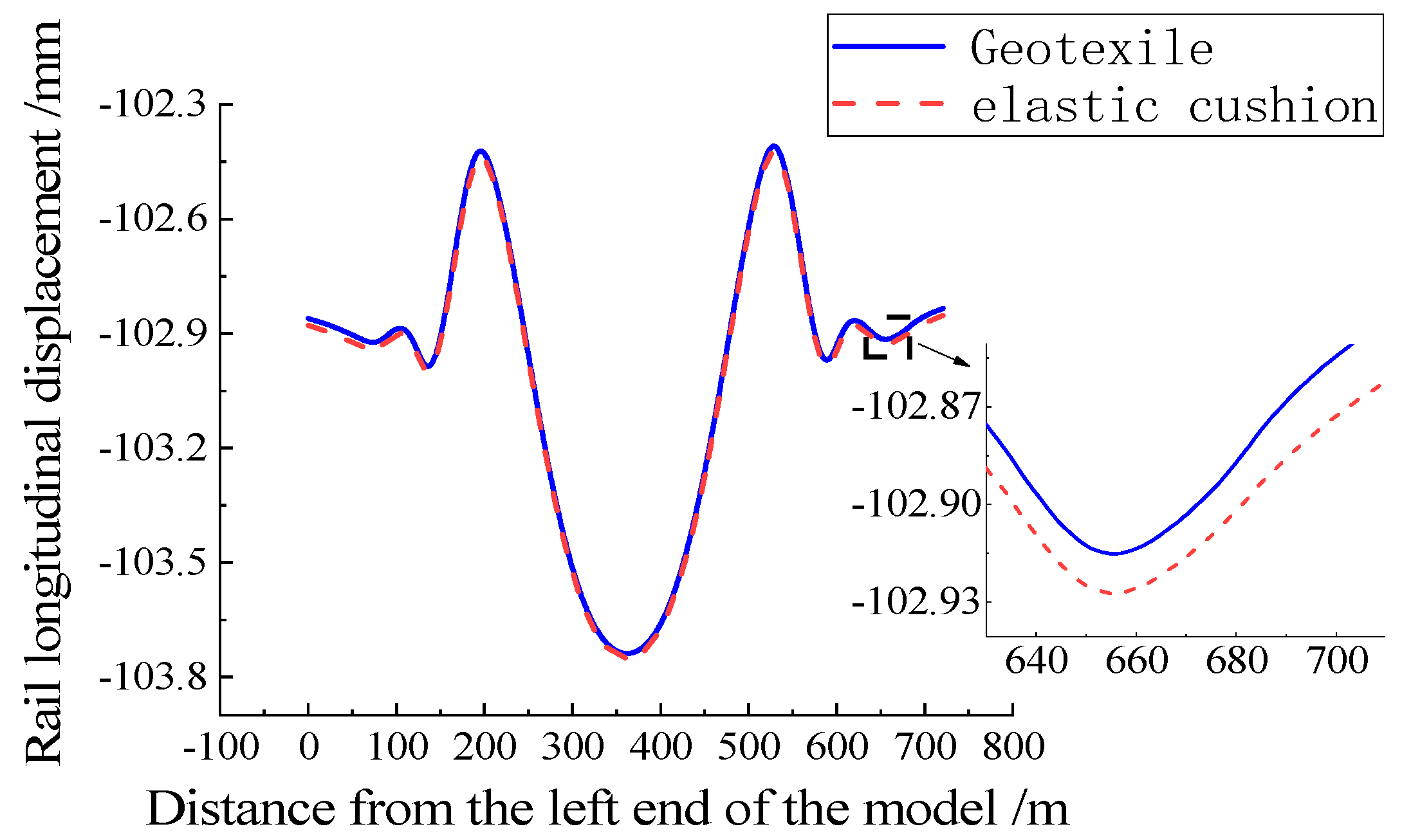
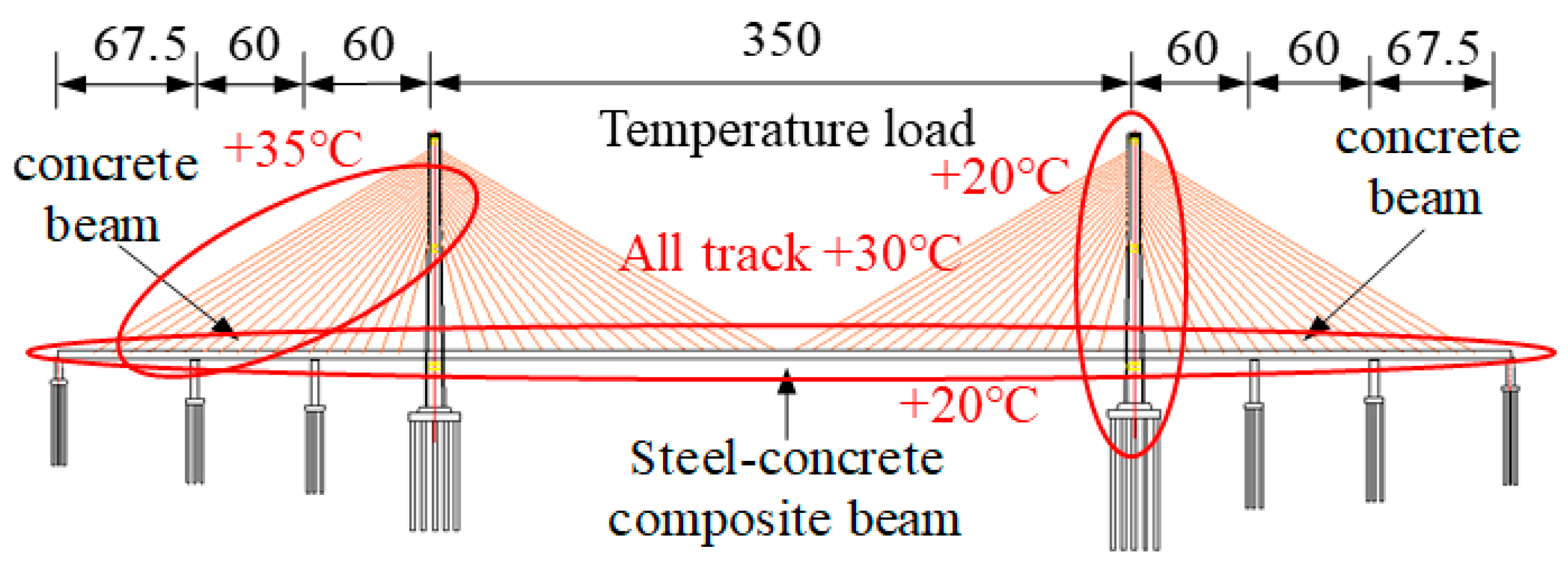


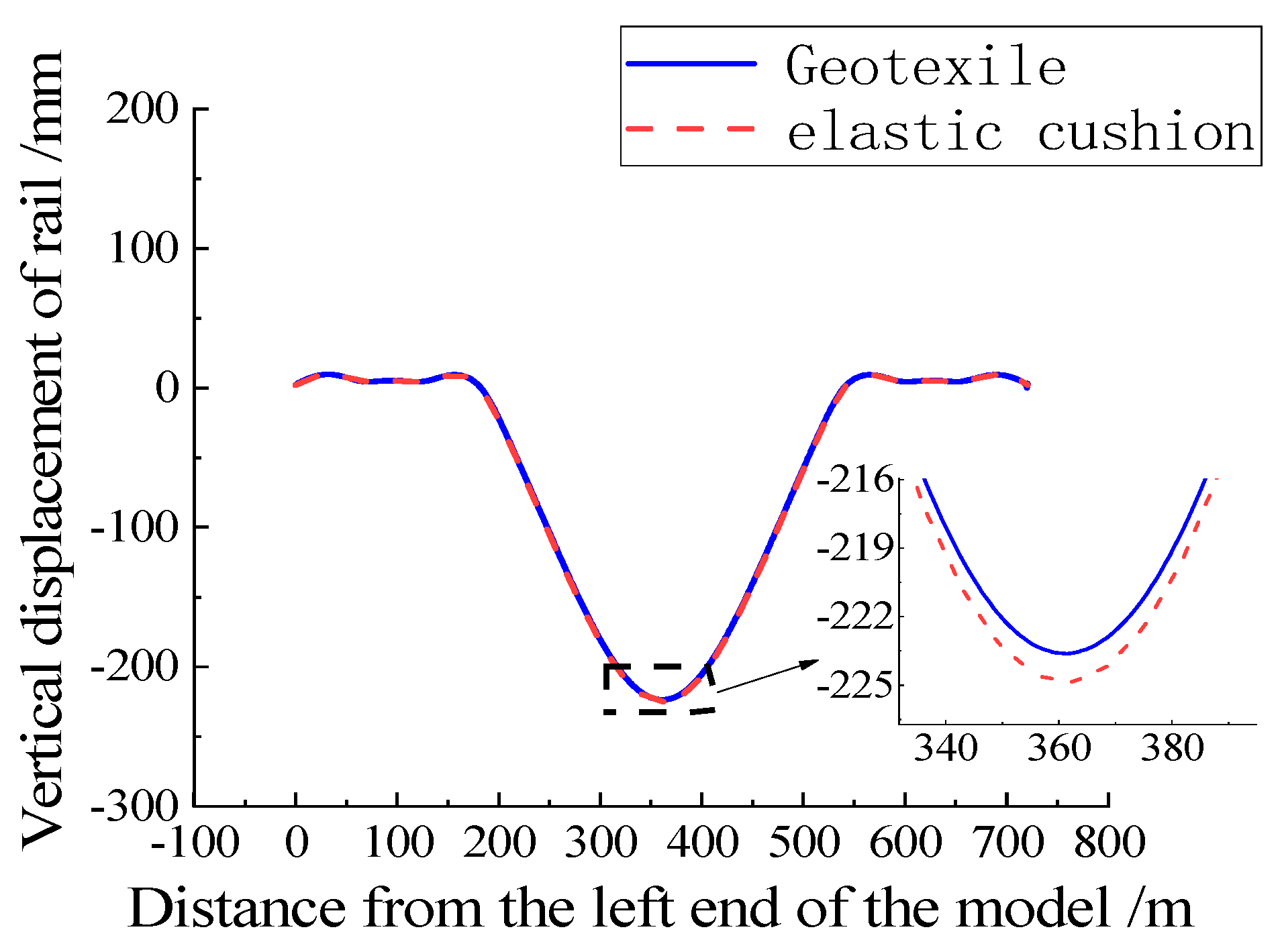


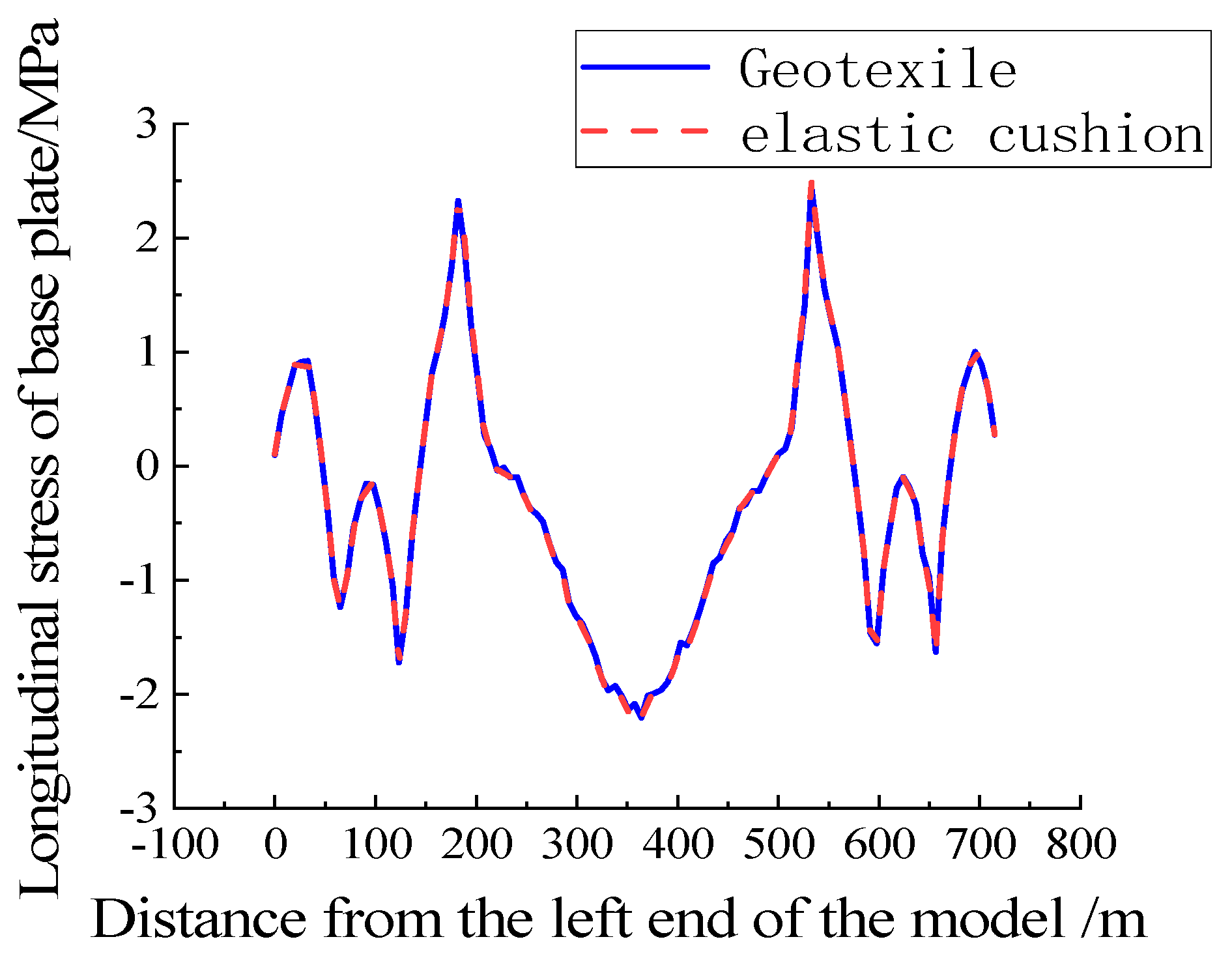




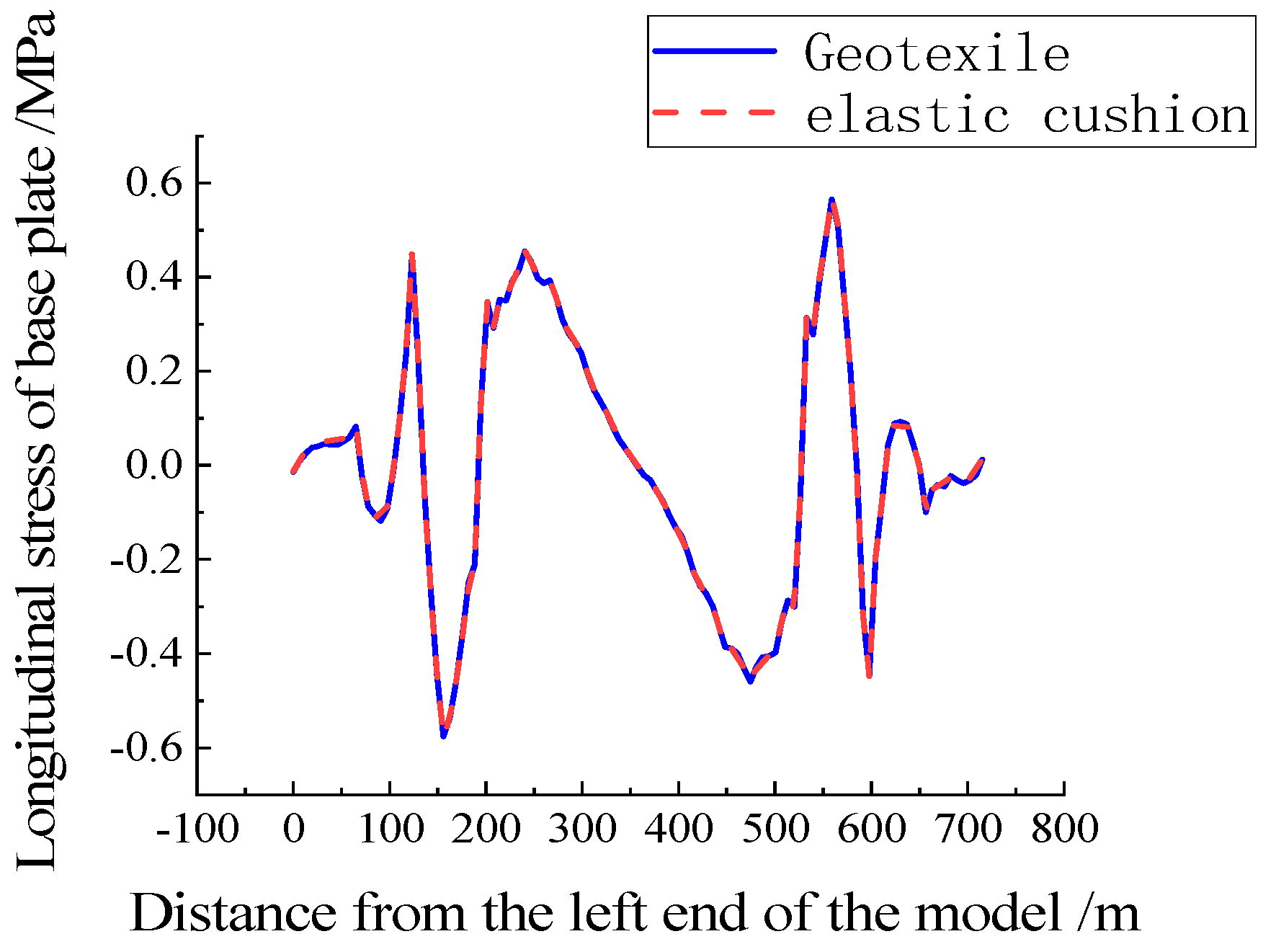

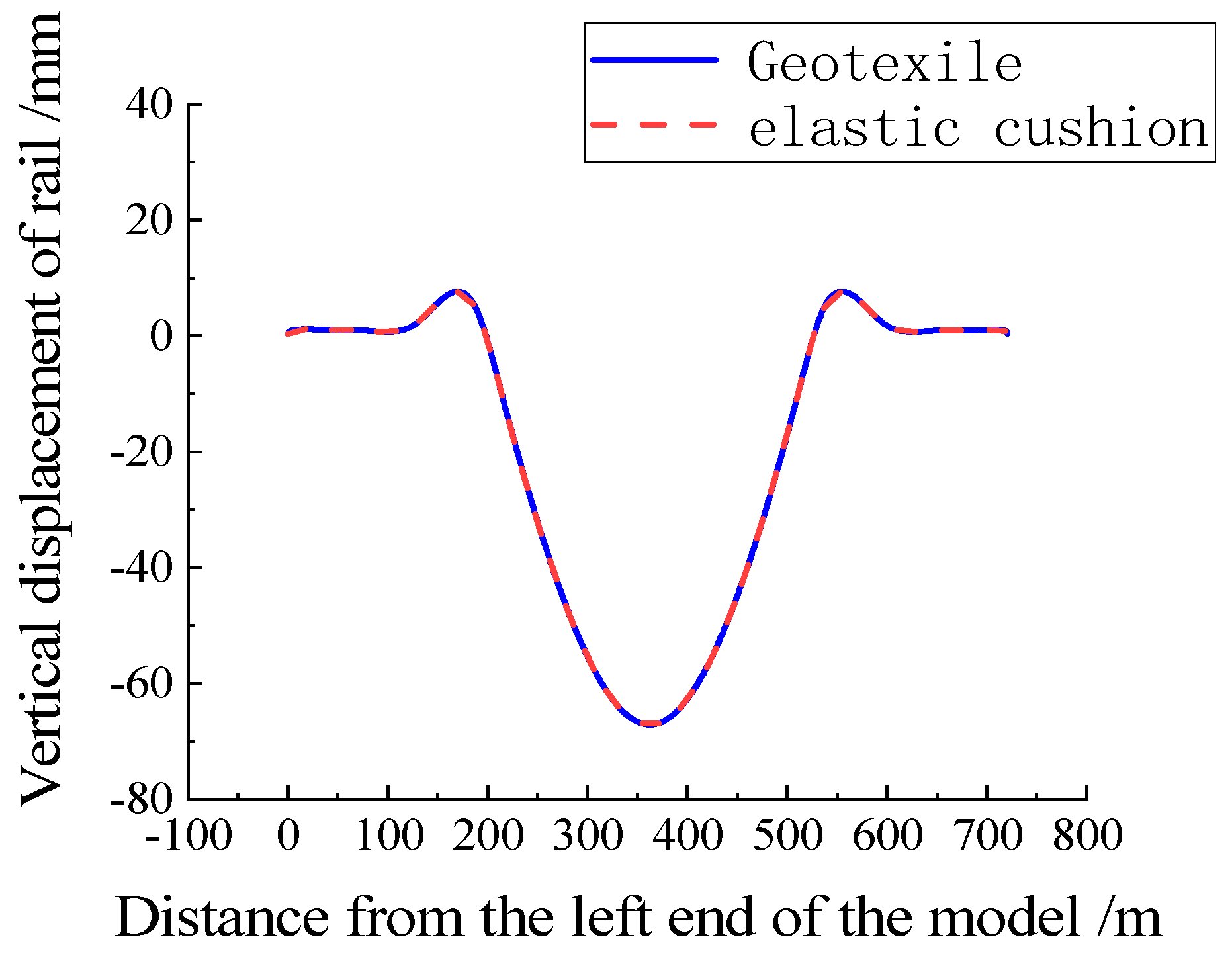

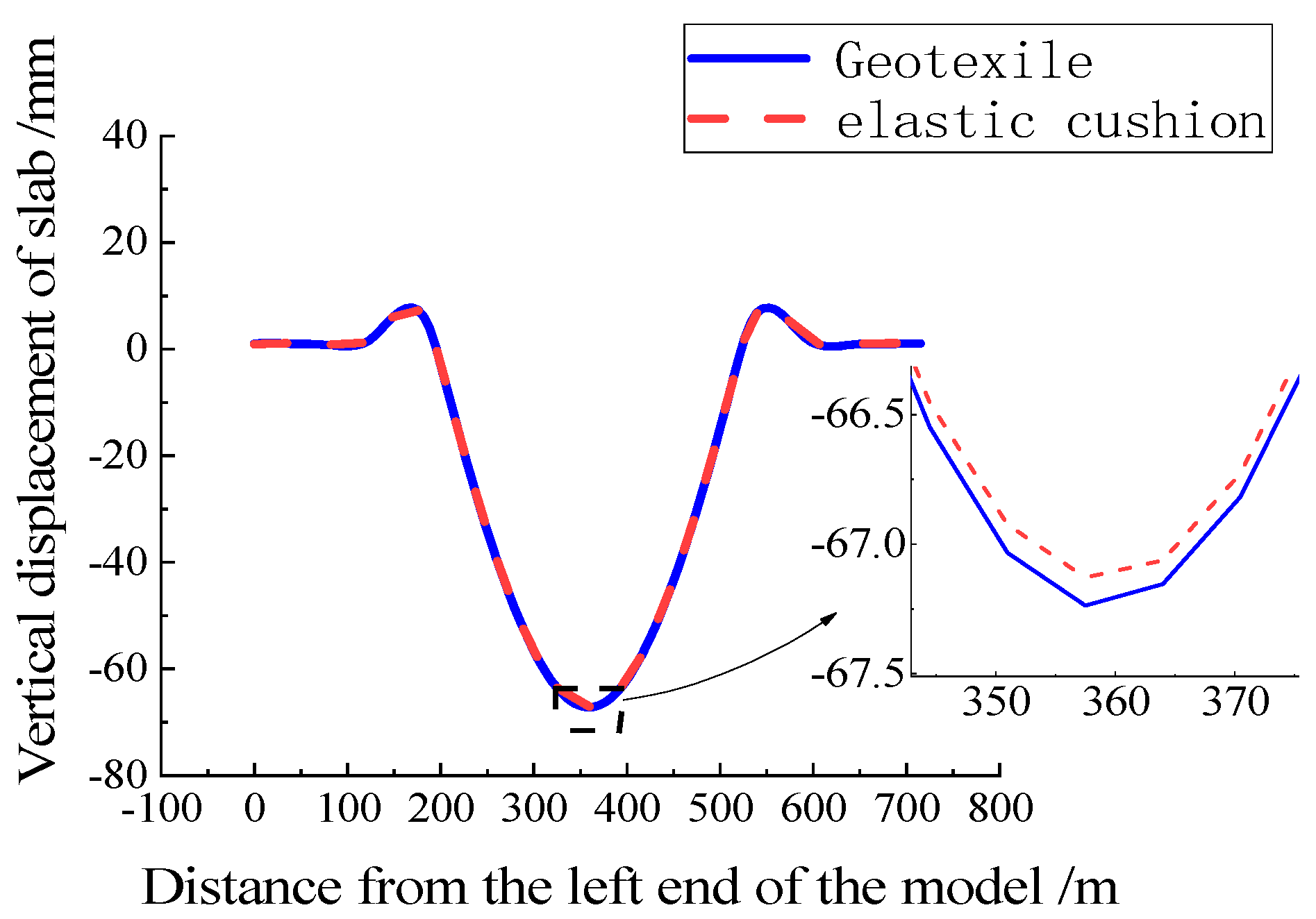
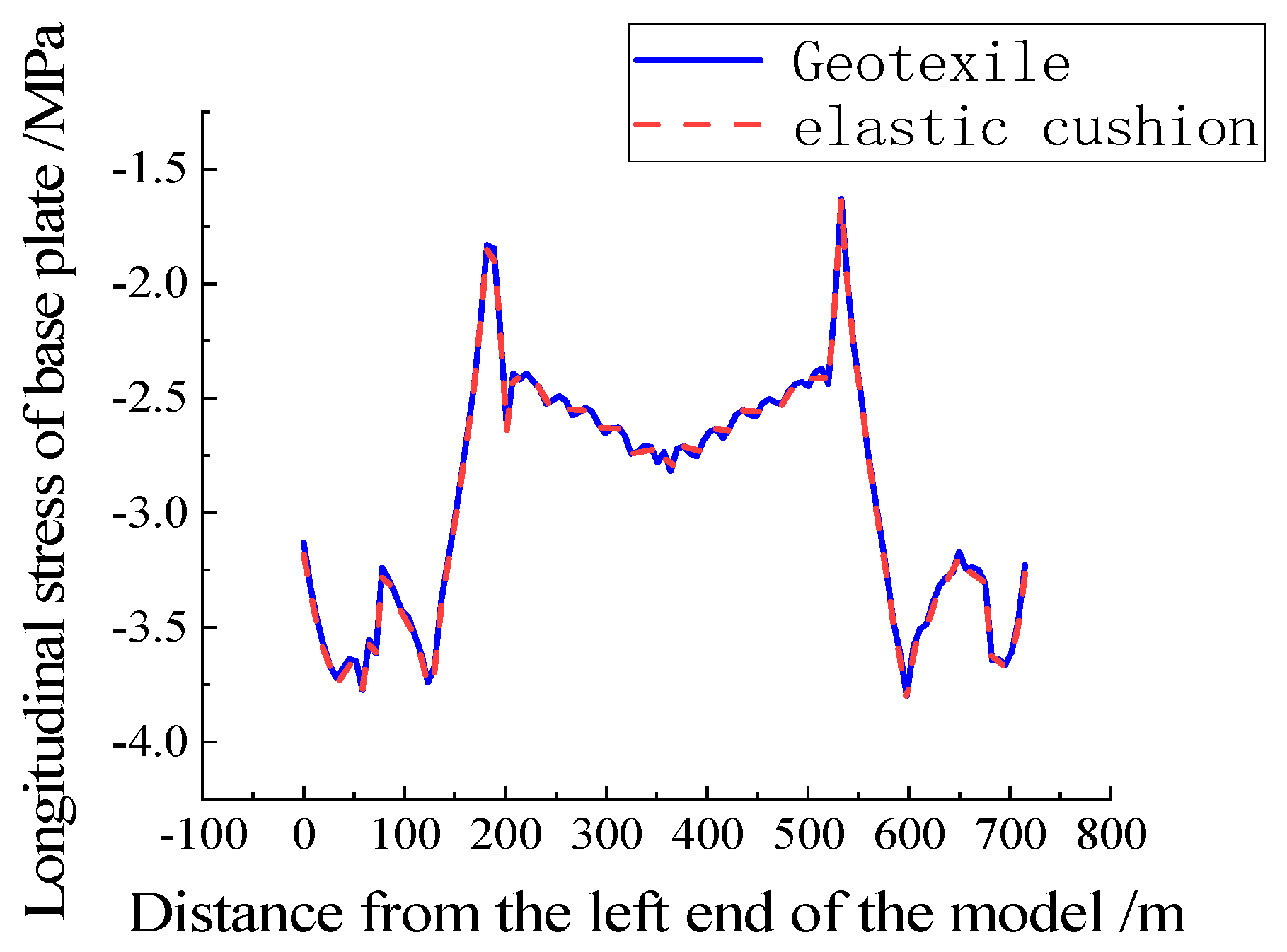


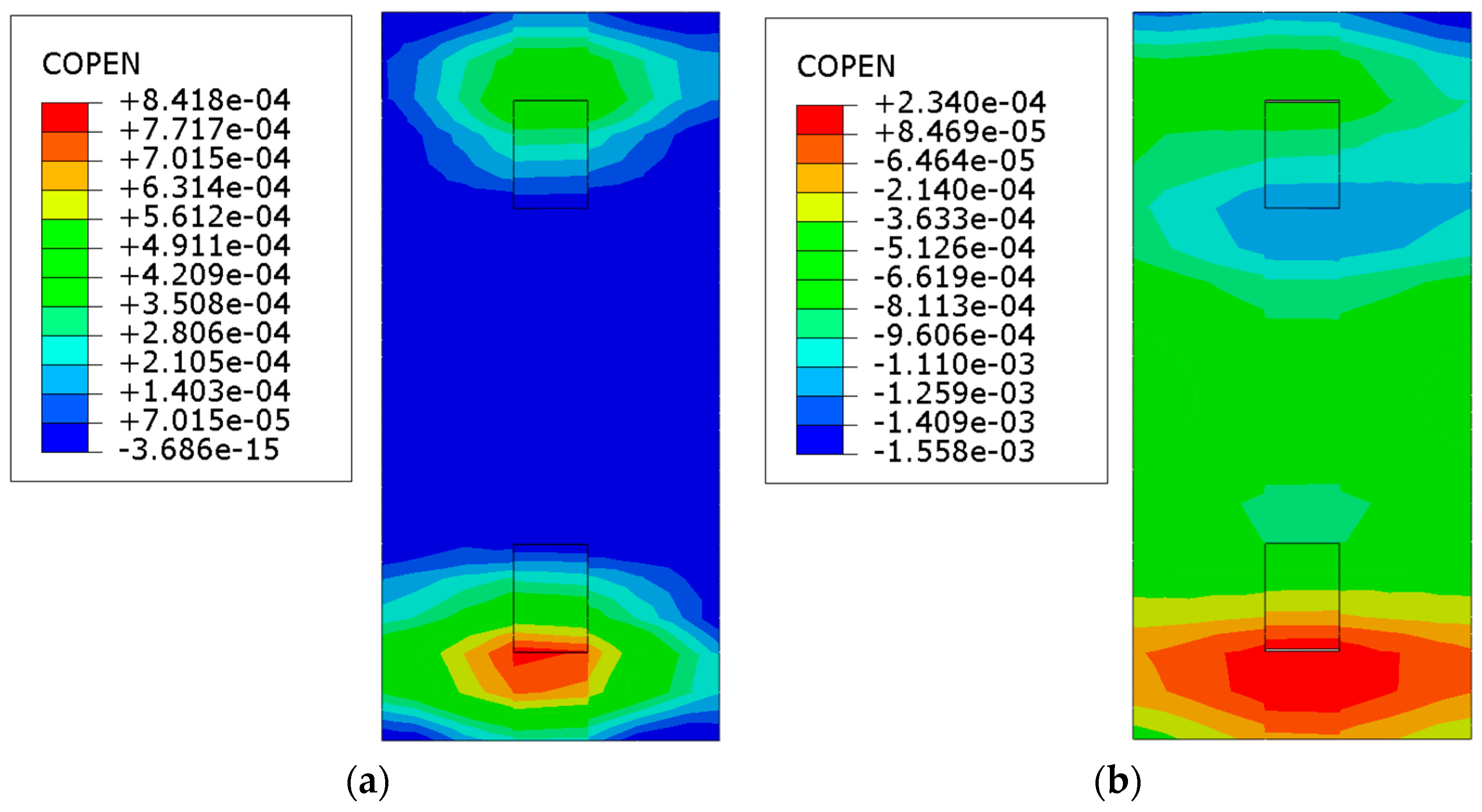
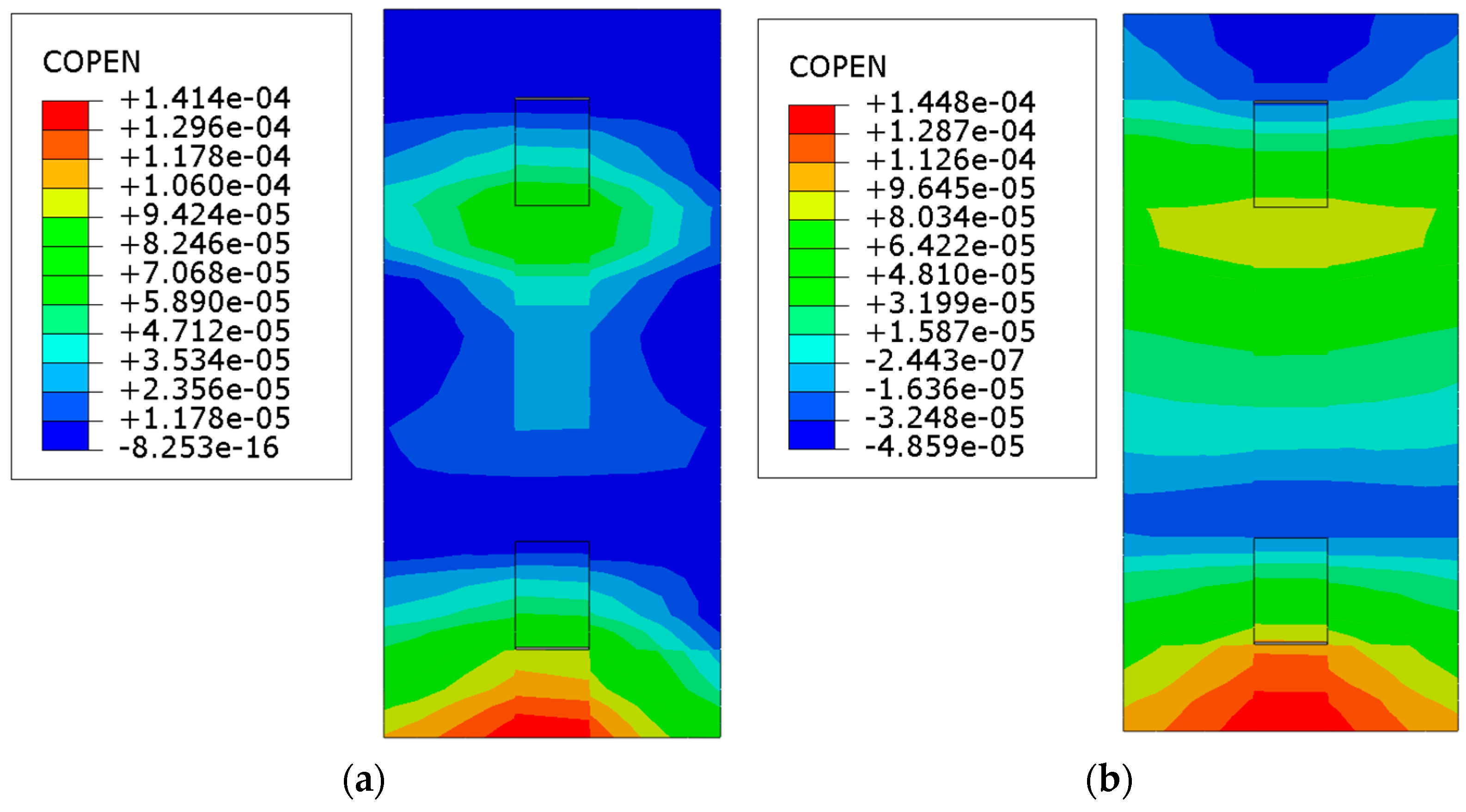
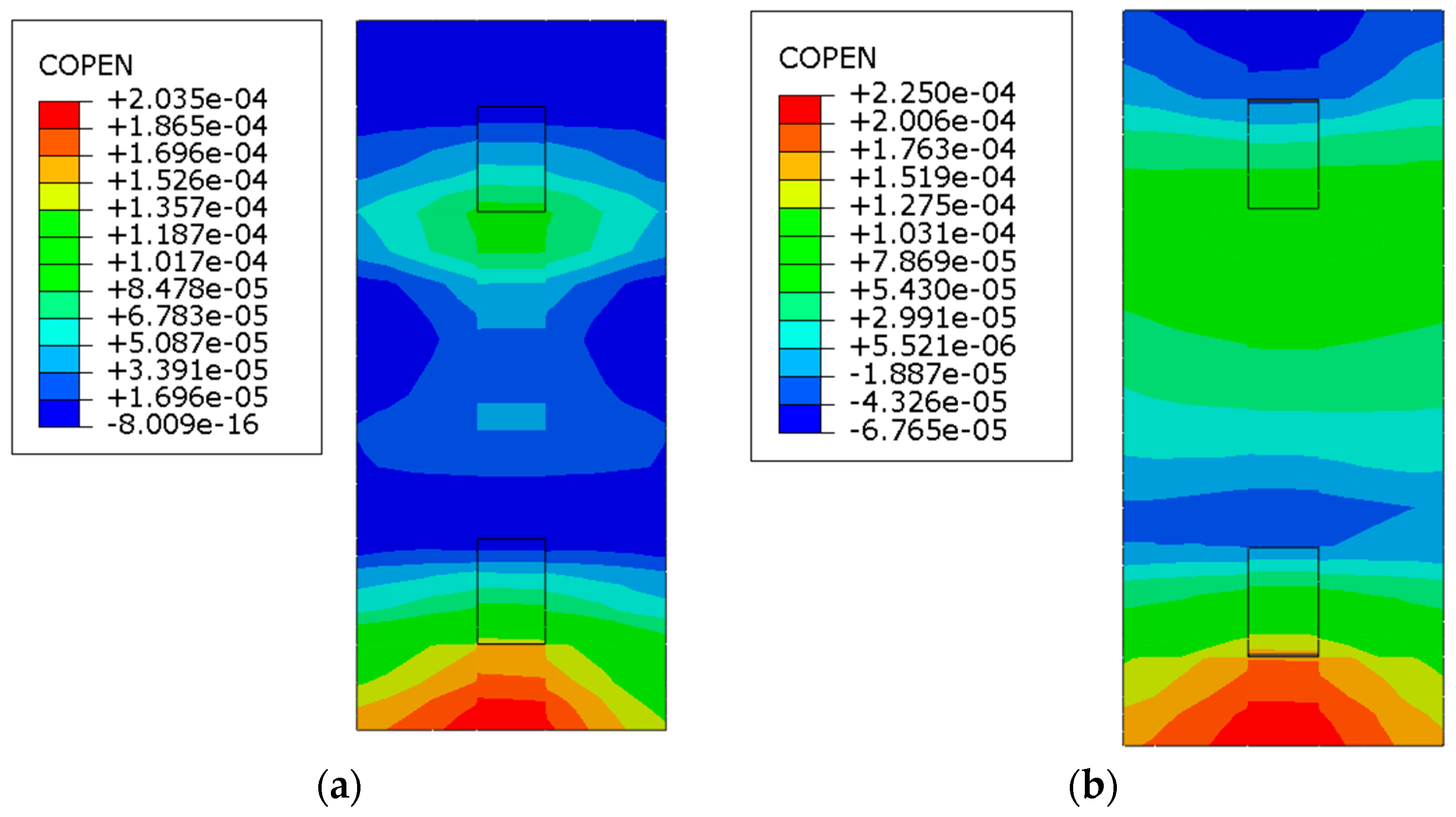

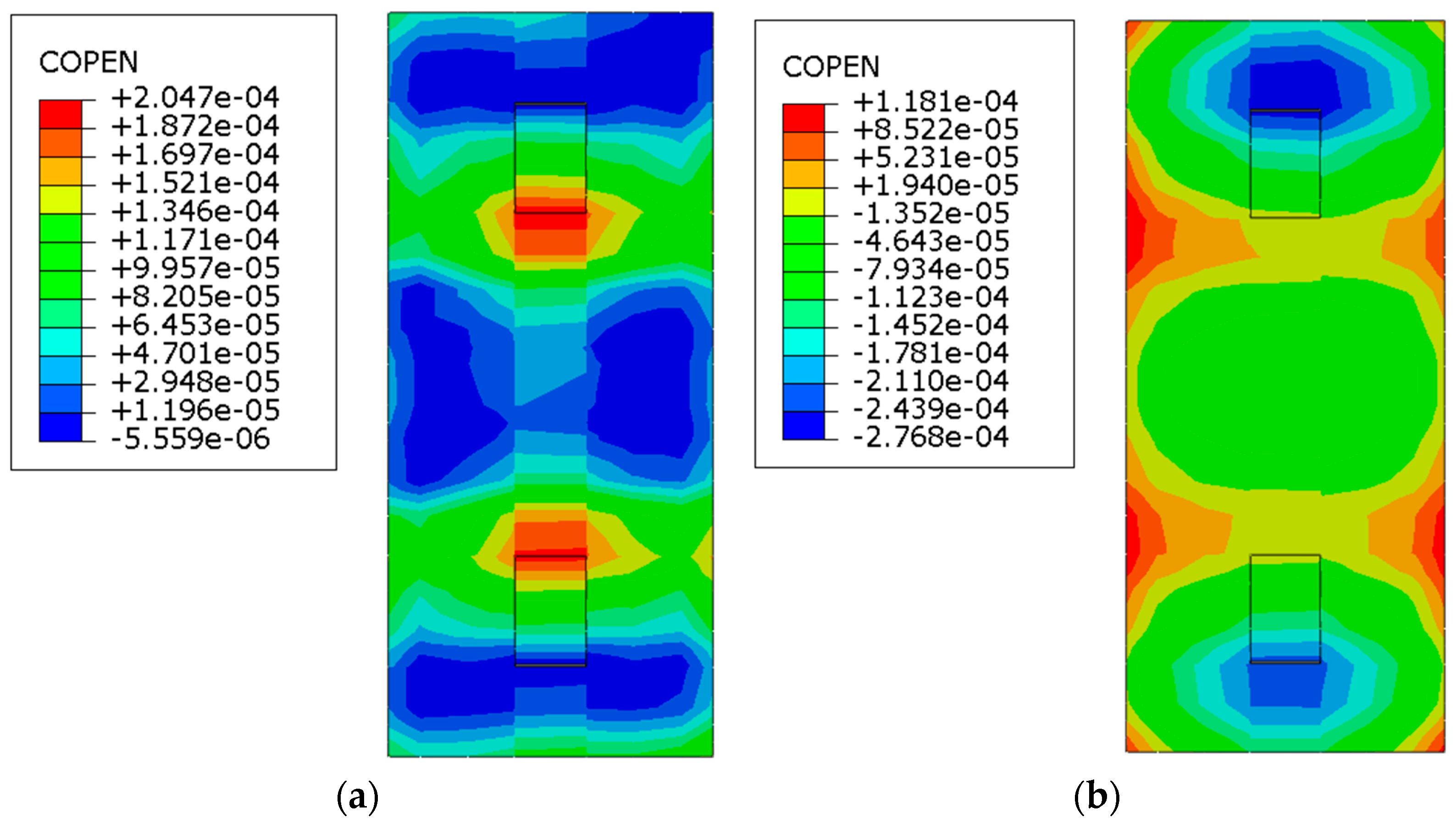
Disclaimer/Publisher’s Note: The statements, opinions and data contained in all publications are solely those of the individual author(s) and contributor(s) and not of MDPI and/or the editor(s). MDPI and/or the editor(s) disclaim responsibility for any injury to people or property resulting from any ideas, methods, instructions or products referred to in the content. |
© 2023 by the authors. Licensee MDPI, Basel, Switzerland. This article is an open access article distributed under the terms and conditions of the Creative Commons Attribution (CC BY) license (https://creativecommons.org/licenses/by/4.0/).
Share and Cite
Cai, J.; Chen, J.; Wang, J.; Shi, X.; Wang, R.; Yang, Y. Research on the Influence of Geotextile and Elastic Cushion on the Static Performance of Ballastless Track on Long-Span Cable-Stayed Bridges. Appl. Sci. 2023, 13, 13110. https://doi.org/10.3390/app132413110
Cai J, Chen J, Wang J, Shi X, Wang R, Yang Y. Research on the Influence of Geotextile and Elastic Cushion on the Static Performance of Ballastless Track on Long-Span Cable-Stayed Bridges. Applied Sciences. 2023; 13(24):13110. https://doi.org/10.3390/app132413110
Chicago/Turabian StyleCai, Jiasheng, Jinjie Chen, Jianxi Wang, Xianfeng Shi, Rui Wang, and Yadi Yang. 2023. "Research on the Influence of Geotextile and Elastic Cushion on the Static Performance of Ballastless Track on Long-Span Cable-Stayed Bridges" Applied Sciences 13, no. 24: 13110. https://doi.org/10.3390/app132413110
APA StyleCai, J., Chen, J., Wang, J., Shi, X., Wang, R., & Yang, Y. (2023). Research on the Influence of Geotextile and Elastic Cushion on the Static Performance of Ballastless Track on Long-Span Cable-Stayed Bridges. Applied Sciences, 13(24), 13110. https://doi.org/10.3390/app132413110






